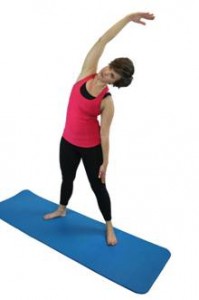Centerworks® “Secret” Training Tips for Mobilizing the Ribcage
Part Four: Lateral Movement of the Spine and Ribs
 There is a lot to think about in order to execute great lateral, side-bending movements.
There is a lot to think about in order to execute great lateral, side-bending movements.
This is not a direction our upper body moves in much for daily life activities. But there is a side-bending lateral motion that happens in the hips and pelvis that is vital for good gait mechanics to walk and run.
Since our upper back should have the most mobility for our spine, and we only get stronger in the ranges of motion that we move in, if we never do anything that involves a side bend, we’ll never have access to the strength and support these muscles have to offer us.
Because we spend most of our time moving forwards and backwards, it IS very important to incorporate exercises into our workouts that bend sideways. There are not many side bending exercises in the Pilates repertoire and I have always considered most of them more Intermediate or Advanced. But everybody needs to be practicing some basic side bending exercises. (Daily would be great!)
Side Bend exercises stretch the back, lifts the ribs away from the hips, and can assist in improving your ability to breathe deeply. Side bending can also quickly point out your strengths weaknesses and muscle imbalances. If you like to cross one leg when you sit and hike up a hip, or lean on one side of an arm rest when you drive your car or sit at your desk, stick your wallet in your back pocket, or always carry your heavy purse on one shoulder, chances are your ribs aren’t even. Side bending might not solve all of your posture problems, but it’s certainly a great place to start to help open things up, get you breathing better and get your back on center.
Initiating Your Side Bend
I bet I had been teaching Pilates for almost 15 years before I had the conscious realization that you could directly control the initiation point for side bending! Depending on which end of the spine you start bending from makes a huge difference on the range of motion, and how the movement feels in the body. In all my years of taking movement training (whether it was Pilates or something else) Nobody had ever cued my side bending movement other than to say, “bend sideways.” But just like bending forward you can start from either end of the spine. When we do the Pilates Roll Up in Mat class we start from the top and work to the waist to fold into forward flexion. And for the Roll Over exercise, the initiation point is the legs and the tailbone to bend the spine – bottom to the top. Joseph Pilates was a genius to develop the exercises and order of execution to practice full range of motion movement from both ends of the body in every workout!
So which end of the spine do YOU typically initiate your side bending exercises? Have you ever paid attention? Sometimes it matters and there is a definite end that needs to go first. But for other exercises, the experience is different and it can be a choice whether you start side bending from the head and work towards the waist, or start from the waist and work up to the head.
One of the first side bending exercises that I introduce to beginners is the Side Bend in the Short Box series on the Reformer. (And a lot of the time, before we try it on the Short Box, I just have clients straddle-sit on the Reformer with their feet grounded on the floor and practice side bending there.)
Whether you’re practicing this exercise straddling the Reformer, seated on the Short-Box, or Standing Tall, you can add variety to the exercise, and train the spine to bend from either end, by being conscious about which end of the spine you’re using to initiate your side bend. The exercise will feel completely different starting from the head vs. starting from the waist. Try it and notice what you feel.
Two Ways to Practice Side Bending to Mobilize the Ribcage for Better Health
- Initiating the side bend from the waist lengthens the spine away from center while you’re bending sideways. I envision pouring tea out of the spout on a tea pot!
- Initiating the side bend from the head brings the top of the spine around sideways into your center.
These two side bends are completely different and both actions are very important for free and easy movement of the entire spine and ribcage. Experiment with the side bending exercises in your next workout and discover how paying attention to moving from the top or the bottom makes a difference to mobilize your ribcage and freely move your spine.
Click HERE for a great video both side bend versions.
****
Check out the entire Mobilizing the Ribcage Series:
- Pilates Training Tips to Mobilize the Ribcage for Better Functional Movement
- Spine Flexion
- Spine Extension
- Spine Rotation and Twisting
- Healthy Spine Movement in Many Directions
*****
Looking for simple exercises to do at home to find and feel the movement of the spine and ribcage we’ve been discussing in these posts?
 Try Pulse Power Fitness! The Daily Dozen: 10 Minute Workout Plan
Try Pulse Power Fitness! The Daily Dozen: 10 Minute Workout Plan. These simple and effective exercises are a great way to get in touch with the deep layers of muscle needed to support good movement habits for your Pilates training and all other sport & fitness activities.
Get Your Copy of Pulse Power NOW!


0 Comments